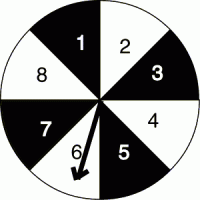
Probability to Lose
I was attracted to this endgame because of the final result at first. The rating difference of about 200 points between the player of the black pieces and the player of the white pieces is not that big a difference when seeing that white is up a pawn and in any rook or pawn endgame he is winning. The knights add some flavor to this otherwise “boring” position. If I let you bet who is going to win this endgame how would you distribute the percentages of draw, win or loss. I would probably go for 60% white wins, 32% draw and 8% chance for white to lose. Given these odds, I am not sure how objective they are, they reflect my evaluation after seeing the position first time. The course of the training games and the analysis of the game itself will show how correct my intuition was.
Let us go to the evaluation of the position. Material-wise white is up a healthy pawn. Four pawns against three pawns on the same flank gives some drawing chances for black, as white will have a hard time creating a passed pawn. Black has some compensation for the lost material in view of the active king and rook. White’s most active piece is the knight on d5 excellently supported by the central pawn e4. Trading one pair of pawns should benefit black as it is easier to draw with less pawns on the board. F5 might be a threat already, as black is ready to support the pawn with the knight and the king. What do you think about rook endgames? The doubled pawns give white more winning chances. On the other hand the black king activity and white’s king passivity give black drawing chances. The pawn endgames should be winning for white. There is a saying that knight endgames are the same as pawn endgames; so we can say that the knight endgames are winning for white here too. In the first game I decided to try my hand at playing white.
The following ideas were important in the first game:
- Going into the rook endgame where black can get the king to f4 is close to a draw. With the king on h2 it is least likely that white will realize an extra pawn. Meanwhile, black will trade all the pawns.
- The pawn endgame with the doubled pawns with equal material is equal.
- Thus, the rook activation Ra1 stumbles on Nf4, which is a real threat to the g2 pawn.
The first game might look to you uneventful but for me it was full of insight. I had to reevaluate my percentages. After this game it seems to me that black has 70 % to draw and white has 25 % to win and 5 % to lose. How could I be so mistaken in my first judgment of the position? The extra pawn is an illusion, black’s activity totally compensates it. In the next game my coach found an interesting way to counter Nf4. At first I thought that the line in the first game is inevitable but…
The interesting ideas are:
- In endgames sometimes knight maneuvers are the ones least expected. At the beginning of the game white found the Nb6-Nc4 maneuver that let white get the d2 square. At the end of the game white didn’t find the Nb1-Nc3–Ne2 maneuver; if he had, I would have had to find: Nf5-Nd4-Ne2-Ng1.
- In the knight endgame if black manages to get the king on f4 and push g4 it is a draw. If white finds a way to secure the f4 square with g3 and defend the e4 pawn with Nd2 then white will have good winning chances.
So much for my initial predictions-- two draws. At least the real game had a decisive result. I couldn’t wait to see how black won this endgame. My guess was white lost on time, while my other guess was that white blundered a mating net. And the second guess came true. Black has only one dangerous idea and there are at least two ways as it was demonstrated in our two games to counter it. The real game is interesting also in that it is a situation where one side is trying to win too hard and loses objectivity. At some point white had to give a perpetual as I point out in the annotations to the game. White had to see that black equalized and the position became dangerous. Winning at all costs sometimes backfires.
For the next week I stumbled upon this endgame while analyzed an opening line. Can you guess from which opening the position is derived? It is pretty hard to figure this out. White’s last move is Re7, find a plan for black or just play it out and see what happens!






